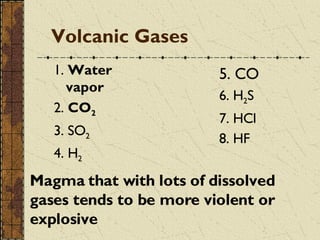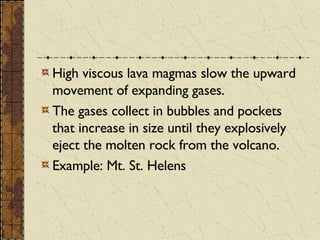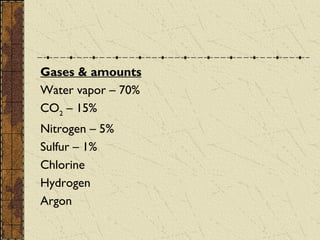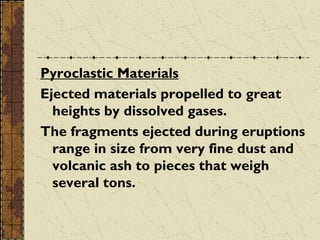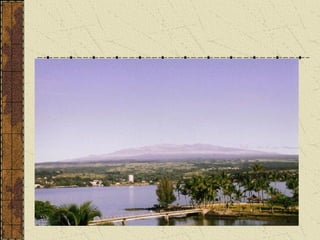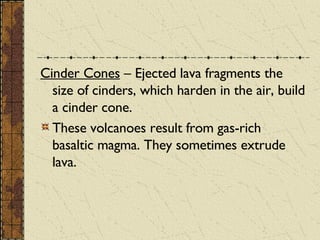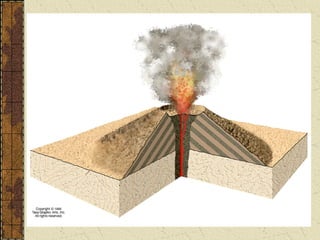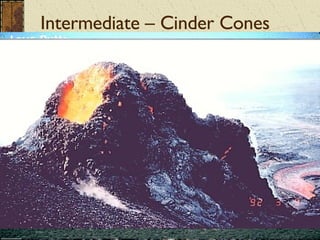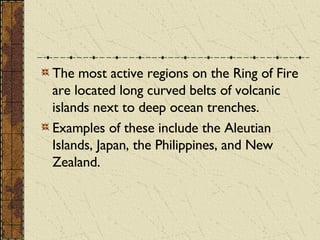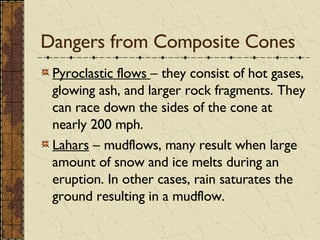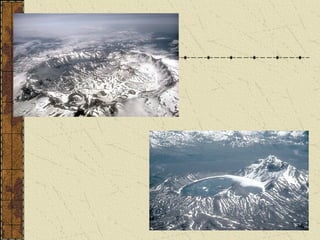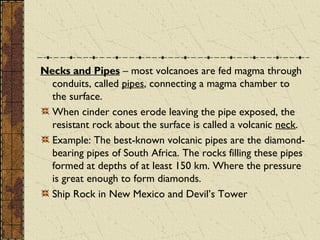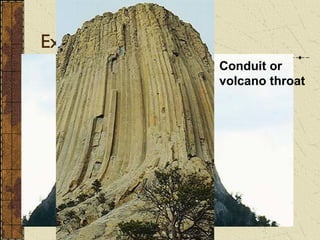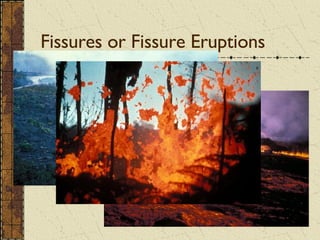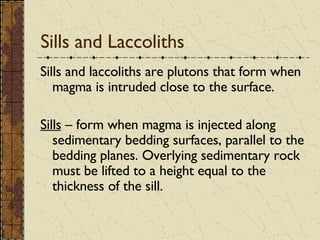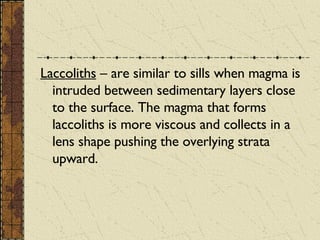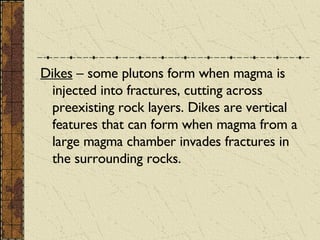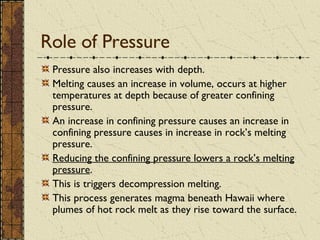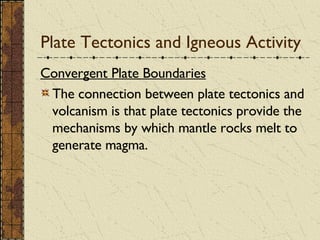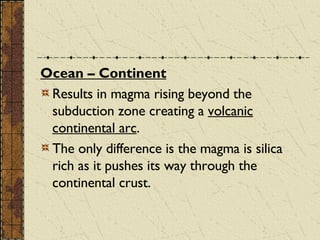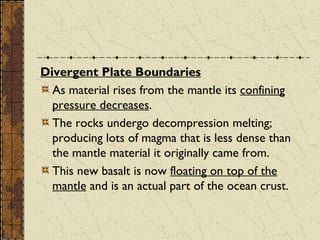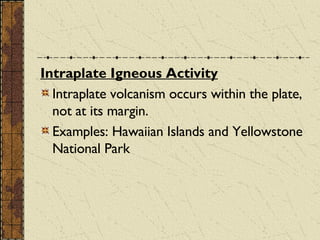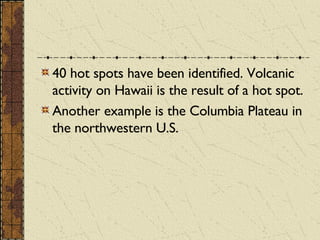Chapter 10notes
- 1. Chapter 10 Volcanoes and other Igneous Activity
- 2. Extra Credit – Inquiry Activity page 279…. Internet research and map plotting…..
- 3. The Nature of Volcanic Eruptions Review the Mt. St. Helens eruption on May 18, 1980.
- 5. Mt. St. Helens Nearly a cubic kilometer of ash and rock debris ejected Yakima, Washington, 130 kilometers to the east, so dark at noon it appeared to be midnight.
- 6. Factors Affecting Eruptions The primary factors that determines whether a volcano erupts violently or quietly include: 1. magma composition 2. magma temperature 3. dissolved gases in the magma
- 7. Viscosity is a substance’s resistance to flow. Example: Maple syrup is more viscous than water. When you heat the syrup is becomes more fluid and less viscous. The mobility of lava is strongly affected by temperature . As the lava cools its viscosity increases, its mobility decreases and the lava comes to a halt.
- 8. The viscosity of magma is directly related to its silica content . Generally, the higher the silica content the higher the viscosity. Because of the silica content, rhyolitic lavas are very viscous and don’t flow easily. Basaltic lavas , which contain less silica, tend to be more fluid .
- 9. Dissolved Gases During explosive eruptions, the gases trapped in magma provide the force to eject molten rock from the vent, or opening to the surface.
- 10. Volcanic Gases 1. Water vapor 2. CO 2 3. SO 2 4. H 2 Magma that with lots of dissolved gases tends to be more violent or explosive 5. CO 6. H 2 S 7. HCl 8. HF
- 11. Air Pollution through a SO 2 Cloud
- 12. As magma rises its pressure is reduced allowing the dissolved gases to be released suddenly. Very fluid basaltic magmas allow expanding gases to bubble upward and escape relatively easily. Therefore, eruptions of fluid basaltic lavas, as in Hawaii, are relatively quiet.
- 13. High viscous lava magmas slow the upward movement of expanding gases. The gases collect in bubbles and pockets that increase in size until they explosively eject the molten rock from the volcano. Example: Mt. St. Helens
- 14. Volcanic Material Lava Flows Pahoehoe – (looks like rope) hot basaltic lavas are usually very fluid because of their low silica content. Flow rates of 10 – 300 meters per hour are common. When basaltic lavas cool they form a relatively smooth skin with wrinkles as the still molten subsurface lava continues to flow. A-A – (block-like) its surface is rough, jagged blocks with dangerously sharp edges.
- 15. Gases The actually percentage of gases in magma is about 1-6 percent of total weight. The actual quantity of gases emitted during an eruption can exceed thousands of tons each day.
- 16. Gases & amounts Water vapor – 70% CO 2 – 15% Nitrogen – 5% Sulfur – 1% Chlorine Hydrogen Argon
- 17. Pyroclastic Materials Ejected materials propelled to great heights by dissolved gases. The fragments ejected during eruptions range in size from very fine dust and volcanic ash to pieces that weigh several tons.
- 18. Size Small bead to walnuts (cinders) are called lapilli Larger than 64 millimeter in diameter are called blocks Ejected glowing lava are called bombs
- 19. Fragments of tephra ejected from volcanoes 1. Dust 2. Ash 3. Cinders 4. Bombs
- 21. Cinders
- 22. Bombs
- 23. Types of Volcanoes Three main types of volcanoes 1. Shield volcanoes 2. Cinder cones 3. Composite Cones
- 24. Anatomy of a Volcano
- 25. Shield Volcanoes – formed by the accumulation of fluid basaltic lavas. These volcanoes are very broad and slightly domed. Most shield volcanoes have grown up from the ocean floor and formed islands. Examples: Hawaii & Iceland
- 28. Mauna Loa Belknap, Oregon
- 29. Kilauea
- 31. Cinder Cones – Ejected lava fragments the size of cinders, which harden in the air, build a cinder cone. These volcanoes result from gas-rich basaltic magma. They sometimes extrude lava.
- 32. Cinder cones have a steep sided shape. They are usually the product of a single eruption that sometimes lasts only a few weeks and rarely more than a few years. Once the eruption ends, the magma in the pipe connecting to the magma chamber solidifies, and the volcano never erupts again. Their cone is usually small from 30 – 300 meters in height.
- 33. There are large numbers of cinder cones around the Earth. Many exist in volcano fields like Flagstaff, Arizona, which consists of 600 cones. Others form on sides of larger volcanoes, for example, Mt. Etna has dozens of cinder cones dotting its flanks.
- 35. Intermediate – Cinder Cones
- 36. Composite Cones – or stratovolcanoes – most are located around the Pacific Ocean in an area called the Ring of Fire . Examples: Andes of South America, Cascade Range in the western U.S. The Cascade Range includes Mt. St. Helens, Mt. Rainier, and Mt. Garibaldi.
- 37. The most active regions on the Ring of Fire are located long curved belts of volcanic islands next to deep ocean trenches. Examples of these include the Aleutian Islands, Japan, the Philippines, and New Zealand.
- 38. A composite cone is a large, nearly symmetrical structure composed of layers of both lava and Pyroclastic deposits. They generally produce very viscous lavas that are gas-rich. Composite cones may generate the most explosive eruptions that eject huge amounts of pyroclastic material. Examples of the classic composite cone include Fujiyama in Japan, Mt. Shasta in California. About 50 composite volcanoes have erupted in the U.S. in the last 200 years.
- 40. Costa Rica Mt. Rainier Mt. Pelee
- 41. Dangers from Composite Cones Pyroclastic flows – they consist of hot gases, glowing ash, and larger rock fragments. They can race down the sides of the cone at nearly 200 mph. Lahars – mudflows, many result when large amount of snow and ice melts during an eruption. In other cases, rain saturates the ground resulting in a mudflow.
- 42. Pyroclastic flows are super heated volcanic materials forming a cloud. This cloud can include volcanic glass
- 43. Landslides Landslides are produced: During the eruption by the explosion By producing enough heat to melt the snow on the volcanic peak
- 44. Lahars Occur when snow melts quickly creating mud flows and landslides Move a tremendous amount of debris Can clog streams and rivers Like other volcanic events, they are very dangerous
- 45. Other Volcanic Features Caldera – is a large depression in a volcano. They may form one of two ways: 1. collapse of the top of the composite volcano after an explosive eruption. 2. the collapse of the top of the composite volcano after the magma chamber is drained. Example: Crater Lake, Oregon, which formed about 7,000 years ago when Mt. Mazama violently erupted and collapsed.
- 48. Necks and Pipes – most volcanoes are fed magma through conduits, called pipes , connecting a magma chamber to the surface. When cinder cones erode leaving the pipe exposed, the resistant rock about the surface is called a volcanic neck . Example: The best-known volcanic pipes are the diamond-bearing pipes of South Africa. The rocks filling these pipes formed at depths of at least 150 km. Where the pressure is great enough to form diamonds. Ship Rock in New Mexico and Devil’s Tower
- 49. Extinct Volcano Conduit or volcano throat
- 50. Lava Plateaus – Material extruded from fissures in great volume over a large area. Example: Columbia Plateau in northwestern U.S. Here large numbers of fissures extruded lava in flows some of which were 50 meters thick and buried the landscape under a plateau nearly 1.6 km. thick.
- 52. Fissures or Fissure Eruptions
- 53. Intrusive Igneous Activity Plutons Structures that result from the cooling and hardening of magma at depth are called plutons. What can these plutons that are formed at depth be exposed at the surface? Erosion Intrusive igneous bodies, or pluton, are classified according to their shape, size, and relationship to the surrounding rock layers.
- 54. Sills and Laccoliths Sills and laccoliths are plutons that form when magma is intruded close to the surface. Sills – form when magma is injected along sedimentary bedding surfaces, parallel to the bedding planes. Overlying sedimentary rock must be lifted to a height equal to the thickness of the sill.
- 55. Laccoliths – are similar to sills when magma is intruded between sedimentary layers close to the surface. The magma that forms laccoliths is more viscous and collects in a lens shape pushing the overlying strata upward.
- 56. Laccolith
- 57. Dikes – some plutons form when magma is injected into fractures, cutting across preexisting rock layers. Dikes are vertical features that can form when magma from a large magma chamber invades fractures in the surrounding rocks.
- 58. Batholiths – are the largest of the intrusive features. Batholiths are very thick. The Idaho batholith covers 40,000 sq. km. A batholith must have a surface exposure greater than 100 sq. km. to be considered.
- 59. Batholiths A batholith is a mass of rock formed when a large body of magma cools inside the crust. Several large batholiths form the core of mountain ranges in western North America. Half Dome in Yosemite National Park, California, is part of the Sierra Nevada batholith.
- 60. Origin of Magma Geologists conclude the magma originates when essentially solid rock, located in the crust and upper mantle, partially melts. The most obvious way to generate magma from solid rock is to raise the temperature above the level at which the rock begins to melt.
- 61. Role of Heat The change of temperature with depth is known as the geothermal gradient . On average, temperature raises between 20-30 0 C per kilometer in the crust. 100 kilometers of depth temperatures range between 1400 - 1600 0 C. This is near but not quite at the melting point of rocks.
- 62. To reach melting point additional heat must be generated. There are several ways: 1. subduction zones – heat is generated by friction 2. Hotter mantle rocks can rise intruding crustal rocks These two processes can create small amount of magma . Large amount of magma can be created without additional heat.
- 63. Role of Pressure Pressure also increases with depth. Melting causes an increase in volume, occurs at higher temperatures at depth because of greater confining pressure. An increase in confining pressure causes an increase in confining pressure causes in increase in rock’s melting pressure. Reducing the confining pressure lowers a rock’s melting pressure . This is triggers decompression melting. This process generates magma beneath Hawaii where plumes of hot rock melt as they rise toward the surface.
- 64. Role of Water Another important factor is water content. Water causes rock to melt at lower temperatures .
- 65. Plate Tectonics and Igneous Activity Convergent Plate Boundaries The connection between plate tectonics and volcanism is that plate tectonics provide the mechanisms by which mantle rocks melt to generate magma.
- 66. Ocean-Ocean Results in a chain of volcanoes on the ocean floor. Eventually, as these structures grow, island arcs are formed.
- 67. Ocean – Continent Results in magma rising beyond the subduction zone creating a volcanic continental arc . The only difference is the magma is silica rich as it pushes its way through the continental crust.
- 68. Divergent Plate Boundaries As material rises from the mantle its confining pressure decreases . The rocks undergo decompression melting; producing lots of magma that is less dense than the mantle material it originally came from. This new basalt is now floating on top of the mantle and is an actual part of the ocean crust.
- 69. Intraplate Igneous Activity Intraplate volcanism occurs within the plate, not at its margin. Examples: Hawaiian Islands and Yellowstone National Park
- 70. Most intraplate volcanism occurs where a mass of hotter than normal magma material called a mantle plume rises toward the surface. Mantle plumes form at the core-mantle boundary. As these plumes rise they undergo decompression melting forming basaltic magma. The result is a small volcanic region a few hundred kilometers across called a hot spot .
- 71. 40 hot spots have been identified. Volcanic activity on Hawaii is the result of a hot spot. Another example is the Columbia Plateau in the northwestern U.S.
- 72. Landforms From Lava and Ash









